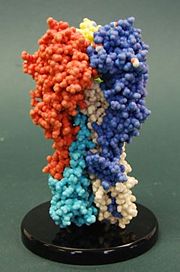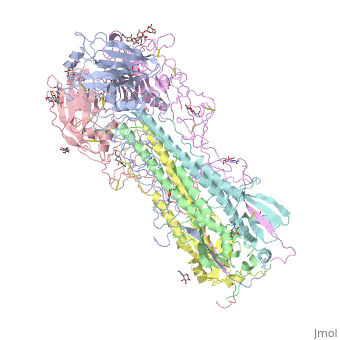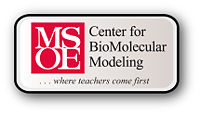Influenza hemagglutinin
From Proteopedia
Influenza hemagglutinin (PDB code 5hmg) is one of two proteins found on the surface of an influenza virus. Hemagglutinin plays a key role in both host cell recognition and membrane fusion.
Contents |
Structure
The hemagglutinin protein is initially assembled into a homo-trimer. Each of the three identical proteins consists of 549 amino acids. Later during the maturation of the virus, the monomers are cleaved by a protease to generate two chains known as HA1 and HA2.
|
HA1
The HA1 protein chain begins at the base of the structure and forms a globular bulb at the top of the structure. This bulbous structure contains sialic acid receptor binding site. The amino acids that line the receptor binding pocket determine the specificity of the virus, that is, whether it can infect human, bird, or swine cells. As this portion of the protein is the most exposed, it is also the site most targeted by immune responses and the most affected by mutation.
HA2
The HA2 protein chain is primarily responsible for facilitating membrane fusion. The C-terminal end of the protein is embedded in the viral membrane. The N-terminal end, known as the fusion peptideconsists of 10 hydrophobic amino acids. When the protein undergoes pH induced conformational changes, this fusion peptide becomes embedded in the host cell membrane. Additionally, the C-terminus embedded in the viral membrane rearranges, bringing the two membranes closer together and facilitation fusion.
pH Induced Conformational Changes
After the virus has bound to the cell membrane, the cell engulfs the viral capsule through the process of endocytosis. Included on the lining of the endosome are ion pumps, were originally used to pump ions out of the cell and maintain a proper pH level. As a part of the endosomal lining, the pumps continue to pump ions, but now into the endsome. This causes the pH surrounding the viral capsule to become acidic.
When the pH level reaches 5.5, the HA1 protein shifts its position, rearranging to allow the HA2 protein to access the endosomal membrane. The HA2 chain begins to rearrange, and the loop shown in blue refolds into a helix at pH5. This causes the HA2 chain to reform into the longest known alpha helix in nature. This allows the fusion peptide to become embedded in the endosomal membrane. The C-terminus of the HA2 also rearranges, positioning the viral membrane in close proximity to the endosomal membrane and allowing membrane fusion to occur. This allows the viral RNA to be released from the capsule and into the host cell cytoplasm.
For schematic diagrame, molecular dynamics simulations, and morph animations that explain membrane fusion in more detail, see SARS-CoV-2 spike protein fusion transformation.
Video
~We hope to have a short video available soon that will display a physical model of this protein and some of the concepts discussed above.
3D structures of influenza hemagglutinin
External Links
MSOE Center for BioMolecular Modeling
The physical models shown on this page were designed and built by the MSOE Center for BioMolecular Modeling. For more information about physical protein modeling, visit the CBM web site at http://cbm.msoe.edu/ .
Additional Resources
For additional information, see: Influenza
Proteopedia Page Contributors and Editors (what is this?)
Savannah Anderson, Tim Herman, Eran Hodis, Michal Harel, David Canner, Eric Martz



